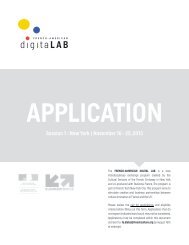REX
BD16_REX
BD16_REX
Create successful ePaper yourself
Turn your PDF publications into a flip-book with our unique Google optimized e-Paper software.
Retours d’expériences Big Data en entreprise<br />
THE NEED FOR SPEED<br />
CIG had been using analytics from SAS for credit-risk modeling for many years, but with the addition of the creditcard<br />
loss forecasting responsibility, it was forced to reassess its use of an internal shared-services environment<br />
to run its modeling and calculation processes. Doing so would help reduce processing time, increase access and<br />
availability of resources for ad hoc analysis, while ensuring business continuity for this mission-critical function of<br />
the bank’s business.<br />
“We needed a solution that addressed today’s business problems, as well as a solution with the flexibility for any<br />
future business requirements,” says Russell Condrich, Senior Vice President, Corporate Investment Group. “Processing<br />
large, multi-terabyte datasets in a quick, efficient manner was a key requirement for us and SAS performed<br />
flawlessly. Without SAS, processing times would be longer, hedging decisions would be delayed and, ultimately,<br />
the bank would be behind the market.”<br />
SAS AND IBM SHOW RESULTS<br />
To meet its performance requirements, the group moved its processing to a dedicated platform comprised of SAS®<br />
Enterprise Risk Management on SAS® Grid Computing, SAS® Scalable Performance Data Server on a 224 core<br />
IBM BladeCenter® grid and the IBM’s XIV® Storage System. The initiative has already produced considerable<br />
results, such as reducing the bank’s probability of default calculation time from 96 hours to just four. Processing<br />
time for ad hoc jobs has been reduced by 90 percent and, according to the CIG, they are processing at three times<br />
the speed of the previous environment.<br />
The platform pulls data from eight systems of record (SOR), amounting to hundreds of millions of records, or 30<br />
terabytes of source data, and allows the SAS environment to consume 3.9 gigabytes of I/O throughput per second<br />
from IBM’s XIV storage environment. Approximately 30 users now have unfettered access to the environment, as<br />
opposed to the shared services environment of the past, in which user time was competitive and response times<br />
varied dramatically due to the high number of jobs being executed.<br />
‘UNPARALLELED’ PERFORMANCE<br />
“We now have an environment that provides users with a robust platform on which to schedule and prioritize jobs,<br />
based on duration or computational requirements, so that ad hoc usage is not competing with scheduled work,”<br />
says Stephen Lange, Managing Director, Corporate Investments Group. “This advanced grid platform is giving us<br />
unparalleled performance. SAS is indispensable for its unique way of handling large data sets.”<br />
As an example, Lange adds, “we have to score a particular portfolio of 400,000 loans with our suite of models,<br />
using multiple scenarios, and we need to run it over the 360 months of the mortgages’ life. That process used to<br />
take three hours, now it takes 10 minutes because of the parallelization capabilities of the grid. The ability to go<br />
from three hours to 10 minutes on a job demonstrates a tremendous increase in our ability to deliver information<br />
and make decisions.”<br />
“The bank has a strong desire to enable loss forecasting as accurately and quickly as possible, right up to the<br />
senior executive layers of the organization,” says Lange. “The only way we can do that is to have sufficient IT<br />
resources to score loans and appropriately assess risks. The partnership between SAS, IBM and our internal technology<br />
group has provided a platform for us to demonstrate risk management leadership.”<br />
CHALLENGE<br />
• Reduce processing time for credit-risk modeling, scoring and loss forecasting.<br />
• Increase ad hoc analysis time while ensuring business continuity and guaranteed “up-time” for these missioncritical<br />
functions.<br />
SOLUTION<br />
• SAS® Enterprise Risk Management<br />
• SAS® Grid Manager<br />
• SAS® Scalable Performance Data Server®<br />
BENEFITS<br />
• Reduced probability of loan default calculation time from 96 hours to just four.<br />
• Yields timely decisions around defaults.<br />
• Reduced its scoring routine of 400,000 loans from three hours to 10 minutes.<br />
• Helps minimize losses and can handle new growth opportunities for bank’s loan portfolio.<br />
• Reduced processing time by 90%.<br />
The results illustrated in this article are specific to the particular situations, business models, data input, and<br />
computing environments described herein. Each SAS customer’s experience is unique based on business and<br />
technical variables and all statements must be considered non-typical. Actual savings, results, and performance<br />
characteristics will vary depending on individual customer configurations and conditions. SAS does not guarantee<br />
or represent that every customer will achieve similar results. The only warranties for SAS products and services are<br />
those that are set forth in the express warranty statements in the written agreement for such products and services.<br />
Nothing herein should be construed as constituting an additional warranty. Customers have shared their successes<br />
with SAS as part of an agreed-upon contractual exchange or project success summarization following a successful<br />
implementation of SAS software. Brand and product names are trademarks of their respective companies.<br />
Document réalisé par la Société Corp Events - Janvier 2015<br />
97







